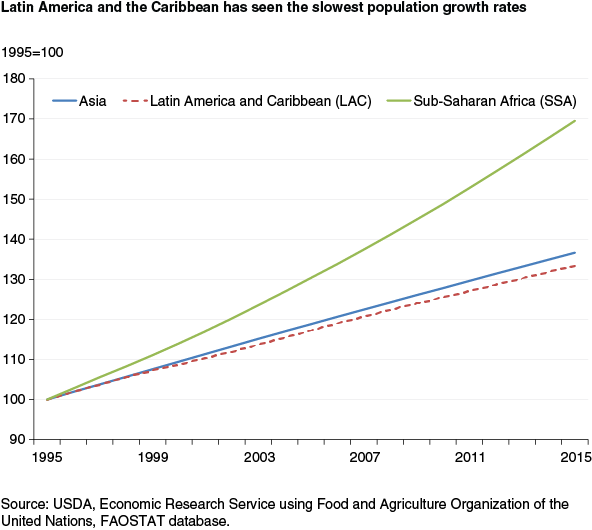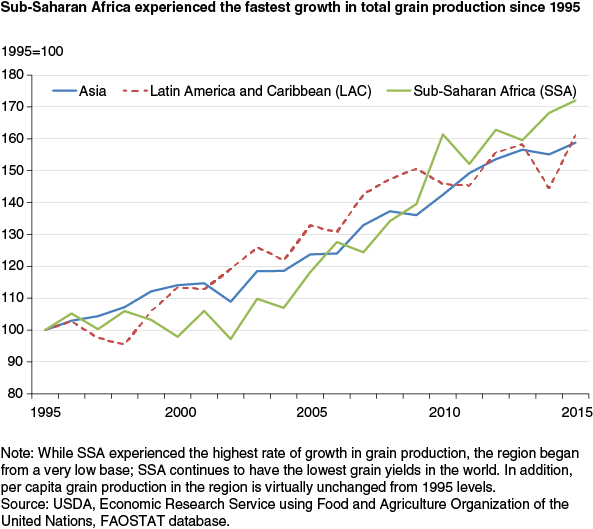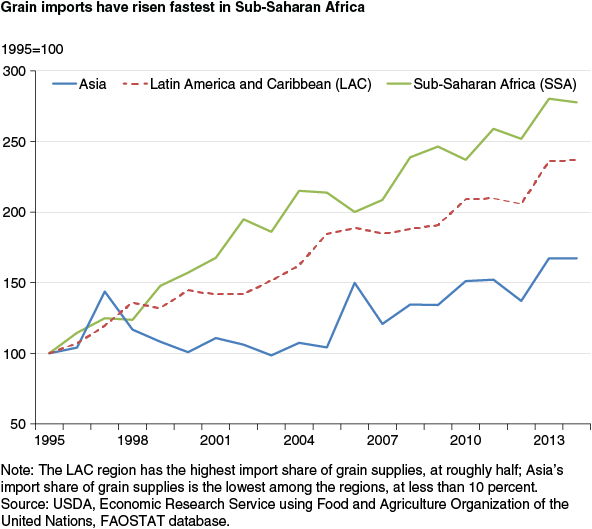International Food Security Assessment: Past Progress and Prospects Through 2025
- by Stacey Rosen and Birgit Meade
- 10/5/2015
Highlights
- Thirty-eight of 76 low- and middle-income countries studied by ERS are estimated to have met the World Food Summit goal, established in 1996, of halving the number of food-insecure people between 1995 and 2015.
- Latin America and the Caribbean region saw the steepest decline in the number of food-insecure people, followed closely by the Asian region.
- However, over the next decade, food security of the study countries is projected to deteriorate at the aggregate level, largely due to several countries in Sub-Saharan Africa and Asia.
In 1996, the United States, the European Community, and 184 other countries gathered at the World Food Summit (WFS) in Rome and pledged to reduce the number of food-insecure people by half by no later than 2015. This declaration emphasized improving the performance of the agricultural sectors, particularly in low-income countries. To that end, there was a call for increased public and private investment in technology and its transfer, improved input distribution, greater access to land and credit, and better integration with world markets.
ERS uses its International Food Security Assessment (IFSA) model to project food availability and access in 76 low- and middle-income countries. In this analysis, a person is defined as food insecure if per capita consumption falls below a target of roughly 2,100 calories per day. Results from the IFSA model are used here to determine which of the 76 countries achieved the WFS goal.
For this analysis, the period of evaluation is from 1995 (1 year prior to the WFS) to 2015 (the goal year). It is important to note that the WFS goal differs from the Millennium Development Goals, which endeavor to cut the share of population that is food insecure by half.
The main drivers of food security are improved food availability and improved access to food. Per capita food availability can increase when domestic production increases faster than population. Production growth is mostly driven by higher yields, as area expansion has stagnated in most countries. Investment in technology and access to inputs and credit all contribute to improved yields. Increased food imports financed by export earnings as well as declining rates of population growth also contribute to increased food availability Food-insecure population groups can gain increased access to food when either rising incomes or declining food prices improve their purchasing power. As part of this analysis using the IFSA model, ERS examines the underlying changes in production, import capacity, population growth, and other variables and their impact on food security.
Between 2015 and 2025, the number of food-insecure people in the 76 countries is projected to rise 31 percent, with the population share that is food insecure rising from 13.4 percent to 15.1 percent. Sub-Saharan Africa (SSA) is projected to account for the bulk of the projected increase in the global food-insecure population, primarily due to prospects for deteriorating food security in a few countries. Civil strife and high population growth are the largest contributing factors.
Latin America and the Caribbean saw the most progress
The number of food-insecure people in the 76 study countries fell from nearly 827 million in 1995 to roughly 475 million in 2015, or nearly 43 percent. Thirty-eight of the 76 study countries have met or exceeded the WFS goal, according to ERS analysis. An additional 10 countries (Indonesia, Pakistan, Sri Lanka, Jamaica, Algeria, Egypt, Morocco, Tunisia, Cape Verde, and Nigeria) were considered food secure in 1995 and (for the most part) through 2015, leaving 28 of the study countries that did not reach the goal.
The Latin America and Caribbean (LAC) region saw the steepest decline in the number of food-insecure people, 68 percent. Six of the 11 LAC countries included in this report have achieved the WFS goal, and most of those countries have exceeded that goal. Countries in this region that made the greatest strides (in terms of percent decline in the number of food-insecure people) include Peru, Colombia, El Salvador, the Dominican Republic, Nicaragua, and Guatemala. Success was derived from growth in commercial grain imports and a slowdown in population growth. The region’s population grew only 33 percent over the 20-year study period. By contrast, population grew 70 percent in SSA.
The Asia region was not far behind LAC, with a 58-percent decline in food-insecure people. Of the 22 Asian countries included in this study, 15 have reached or exceeded the WFS goal. Countries that excelled in this region include Vietnam, Nepal, Laos, Cambodia, Bangladesh, and the Commonwealth of Independent States (CIS) region. Success was generally due to improved grain yields.
The number of food-insecure people in Sub-Saharan Africa fell just 10 percent from 1995 to 2015, but 17 of the 39 countries included in the region are estimated to have achieved the WFS goal. Countries with the greatest success include Cameroon, Sudan, Angola, Malawi, Ghana, Guinea, and Niger. In Sub-Saharan Africa, progress toward food security was largely due to area expansion in grains and roots/tubers, as well as increased imports in many countries. In fact, grain production grew fastest (72 percent) in SSA, compared with 61 percent in LAC and 59 percent in Asia. SSA’s grain imports grew nearly threefold during the study period.
However, when comparing per capita levels over time, grain production growth in SSA, while fast, barely kept pace with population growth, leading to virtually unchanged per capita production between 1995 and 2015.
Food insecurity is most intense in Sub-Saharan Africa in 2015
Sub-Saharan Africa (SSA) is the most vulnerable region to food insecurity in the study. The 39 SSA countries studied account for about 25 percent of the population of the 76 countries covered, but more than half of the food-insecure population in 2015. The intensity of food insecurity in the region is highlighted by the fact that SSA accounts for roughly 90 percent of the distribution gap in 2015 ( see box “How Food Security Is Measured Using the IFSA Model”). In 9 SSA countries, 90 percent or more of the population are estimated to be food insecure: the Central African Republic, the Democratic Republic of Congo, Burundi, Eritrea, Somalia, Lesotho, Swaziland, Zimbabwe, and Chad. Many of these countries have had prolonged civil strife.
The 22 Asian countries included in this study account for nearly two-thirds of the population of the 76 countries in 2015 but are estimated to account for just 41 percent of the number of food-insecure people and only 6.3 percent of the distribution gap. These results indicate the relative well-being of the region and the relatively low level of intensity of food insecurity, at the aggregate level.
In most of the Asian countries included in this study, estimated consumption by even the lowest income decile is roughly 90 percent of the nutritional target. The region has the least skewed distribution of income among the regions studied: the lowest income decile holds 3.4 percent of total income while the highest decile holds roughly 30 percent. By comparison, in the Latin American countries, where income is the most highly skewed among study regions, the lowest decile holds 1.2 percent of income while the highest decile holds over 40 percent.
The 11 countries included in the Latin American and Caribbean region account for less than 5 percent of the population of the 76 countries. The region’s share of the number of food-insecure people is estimated to be slightly higher than that, at 5.4 percent, but its share of the distribution gap is lower, about 4 percent, in 2015. As with Asia, this is an indicator of the relative well-being of the region, which has increasingly relied on imports to augment food supplies.
Long-term food security is projected to deteriorate
Over the next decade, food security in these study countries is projected to deteriorate at the aggregate level. The share of the population that is food insecure is projected to rise from 13.4 percent in 2015 to just over 15 percent in 2025. The number of food-insecure people is projected to rise to 31 percent, while the distribution gap widens even more, to nearly 37 percent. These trends suggest an increase in the intensity of food insecurity through 2025. SSA suffers the greatest increase in food-insecure people, but the number also rises in Asia. However, within both regions, prospects vary widely among countries.
| Year | Total | Asia | LAC | NA | SSA |
|---|---|---|---|---|---|
| 2014 | 521 | 235 | 31 | 0 | 255 |
| 2015 | 475 | 195 | 25 | 0 | 254 |
| 2022 | 622 | 256 | 19 | 0 | 347 |
| LAC = Latin America and Caribbean. NA = North Africa. SSA = Sub-Saharan Africa. Source: USDA, Economic Research Service. |
|||||
| Year | Total | Asia | LAC | NA | SSA |
|---|---|---|---|---|---|
| 2014 | 12,571 | 1,474 | 550 | - | 10,547 |
| 2015 | 11,802 | 738 | 490 | - | 10,574 |
| 2022 | 16,120 | 1,131 | 353 | - | 14,636 |
| *The estimated distribution gap measures the food needed to raise average consumption in each food-deficit income decile to the nutritional target (in grain equivalent). LAC = Latin America and Caribbean. NA = North Africa. SSA = Sub-Saharan Africa. Source: USDA, Economic Research Service. |
|||||
SSA’s food security is projected to deteriorate over the next decade, at the aggregate level, as the number of food-insecure people is projected to rise nearly 37 percent, reaching 347 million in 2025. This projected increase outpaces the growth in total population for the region, so the share of food-insecure people is projected to rise, from 28.4 to 30.4 percent between 2015 and 2025. The distribution gap is projected to rise at a slightly higher rate, 38.4 percent, than the food-insecure population, meaning negligible increase in the intensity of food insecurity in the region.
This aggregate regional trend masks wide variations in individual country results, with developments in a few countries driving most of the projected increase in the number of food-insecure people in the region. The share of the SSA population that is food insecure is projected to rise in only 8 of the 39 SSA countries over the next decade. In fact, in 20 of the countries, 80 percent or more of the population is food secure.
For the most part, the countries where the number of food-insecure people is projected to rise are also those that have endured long-standing civil strife and where prospects for stability and economic growth are not favorable. These include Central African Republic, the Democratic Republic of Congo, Burundi, and Somalia. However, the greatest deterioration is projected for Uganda where the share of population that is food insecure is expected to rise from 20 percent in 2015 to 60 percent in 2025, with the distribution gap increasing sixfold. These results are driven by the country’s high population growth, 3.4 percent per year in the near term and 3 percent per year by 2025. Even the projected 3.3-percent annual growth in grain output growth cannot offset this rise in population. However, the depth of food insecurity in Uganda is not projected to be as intense as in many other SSA countries. For nearly the entire population, per capita consumption does not fall far below the nutritional target. In 2025, consumption in the lowest income decile is projected at 86 percent of the target.
Deteriorating stability in Afghanistan and Yemen are the primary drivers in Asia’s increased share of population that is food insecure—from 8.4 percent to 9.9 percent by 2025. The number of food-insecure people in the region is projected to rise 31 percent by 2025 while the distribution gap jumps 53 percent. This disparity suggests a significant rise in the intensity of food insecurity. While the food security situation is projected to deteriorate in Afghanistan through 2025, it will remain far better than conditions in the mid-2000s when nearly the entire population was estimated to be food insecure. In 2015, 20 percent of the population is projected to be food insecure, with this share projected to rise to 40 percent in 2025. Grain output is projected to grow faster than the regional average but still fall short of population growth of roughly 2.4 percent per year.
The share of Yemen’s population that is food insecure is projected to rise from 20 percent in 2015 to 60 percent in 2025. For most of the 2000s, this share was around 70-80 percent. Yemen’s relatively food-secure standing in 2015 is due to a recent rise in food imports, likely driven by lower global prices for food. Yemen relies on imports for roughly 80 percent of grain supplies, so food security is largely predicated on food import capacity. In the longer term, projections indicate slower growth in import capacity, reducing Yemen’s food security. However, the situation in most Asian countries is projected to remain stable or improve. In more than half of the countries in the region, less than 10 percent of the population is projected to be food insecure by 2025.
Over the next decade, LAC’s distribution gap is projected to decline by 28 percent, a slightly steeper decline than the number of food-insecure people, indicating a small reduction in the intensity of food insecurity. The share of the region’s population that is food insecure is projected to fall from 15 percent in 2015 to 10.6 percent in 2025. The improvement is expected to occur in nearly all of the countries studied in the region.
This article is drawn from:
- Rosen, S., Meade, B. & Murray, A. (2015). International Food Security Assessment, 2015-25. U.S. Department of Agriculture, Economic Research Service. GFA-26.
You may also like:
- Meade, B., Rosen, S. & Beghin, J. (2015). A Consistent Food Demand Framework for International Food Security Assessment. U.S. Department of Agriculture, Economic Research Service. TB-1941.
- Food and Agriculture Organization of the United Nations. (2015). FAOSTAT database.
- Food and Agriculture Organization of the United Nations. (2015). The State of Food Insecurity in the World (SOFI).
- World Bank. (2015). World Development Indicators database.





